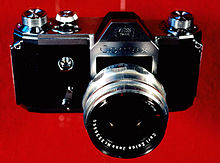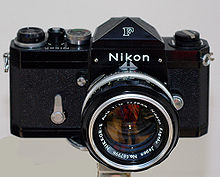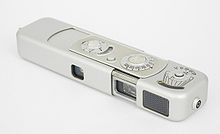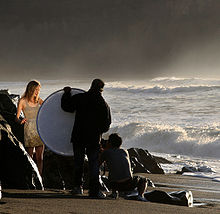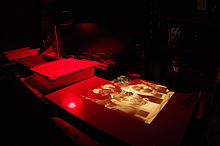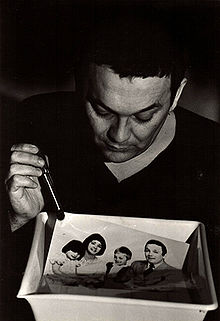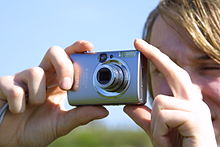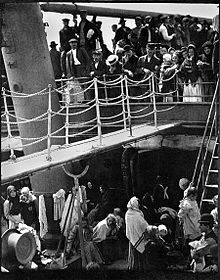- Photography
-
Photography is the art, science and practice of creating durable images by recording light or other electromagnetic radiation, either electronically by means of an image sensor or chemically by means of a light-sensitive material such as photographic film.[1] Typically, a lens is used to focus the light reflected or emitted from objects into a real image on the light-sensitive surface inside a camera during a timed exposure. The result in an electronic image sensor is an electrical charge at each pixel, which is electronically processed and stored in a digital image file for subsequent display or processing. The result in a photographic emulsion is an invisible latent image, which is later chemically developed into a visible image, either negative or positive depending on the purpose of the photographic material and the method of processing. A negative image on film is traditionally used to photographically create a positive image on a paper base, known as a print, either by using an enlarger or by contact printing.
Photography has many uses for business, science, manufacturing (e.g. Photolithography), art, and recreational purposes.
 Lens and mounting of a large-format camera.
Lens and mounting of a large-format camera.
As far as can be ascertained, it was Sir John Herschel in a lecture before the Royal Society of London, on March 14, 1839 who made the word "photography" known to the world. But in an article published on February 25 of the same year in a German newspaper called the Vossische Zeitung, Johann von Maedler, a Berlin astronomer, had used the word photography already.[2] The word photography is based on the Greek φῶς (photos) "light" and γραφή (graphé) "representation by means of lines" or "drawing", together meaning "drawing with light".[3]
Contents
Function
The camera is the image-forming device, and photographic film or a silicon electronic image sensor is the sensing medium. The respective recording medium can be the film itself, or a digital electronic or magnetic memory.[4]
Photographers control the camera and lens to "expose" the light recording material (such as film) to the required amount of light to form a "latent image" (on film) or "raw file" (in digital cameras) which, after appropriate processing, is converted to a usable image. Digital cameras use an electronic image sensor based on light-sensitive electronics such as charge-coupled device (CCD) or complementary metal-oxide-semiconductor (CMOS) technology. The resulting digital image is stored electronically, but can be reproduced on paper or film.
The camera (or 'camera obscura') is a dark room or chamber from which, as far as possible, all light is excluded except the light that forms the image. The subject being photographed, however, must be illuminated. Cameras can range from small to very large, a whole room that is kept dark while the object to be photographed is in another room where it is properly illuminated. This was common for reproduction photography of flat copy when large film negatives were used. A general principle known from the birth of photography is that the smaller the camera, the brighter the image. This meant that as soon as photographic materials became sensitive enough (fast enough) to take candid or what were called genre pictures, small detective cameras were used, some of them disguised as a tie pin that was really a lens, as a piece of luggage or even a pocket watch (the Ticka camera).
The discovery of the 'camera obscura' that provides an image of a scene is very old, dating back to ancient China. Leonardo da Vinci mentions natural camera obscuras that are formed by dark caves on the edge of a sunlit valley. A hole in the cave wall will act as a pinhole camera and project a laterally reversed, upside down image on a piece of paper. So the invention of photography was really concerned with finding a means to fix and retain the image in the camera obscura. This in fact occurred first using the reproduction of images without a camera when Josiah Wedgewood, from the famous family of potters, obtained copies of paintings on leather using silver salts. As he had no way of fixing them, that is to say to stabilize the image by washing out the non exposed silver salts, they turned completely black in the light and had to be kept in a dark room for viewing.
Renaissance painters used the camera obscura which, in fact, gives the optical rendering in color that dominates Western Art. The Camera Obscura literally means "dark chamber" in Latin. It is a box with a hole in it which allows light to go through and create an image onto the piece of paper.
The movie camera is a type of photographic camera which takes a rapid sequence of photographs on strips of film. In contrast to a still camera, which captures a single snapshot at a time, the movie camera takes a series of images, each called a "frame". This is accomplished through an intermittent mechanism. The frames are later played back in a movie projector at a specific speed, called the "frame rate" (number of frames per second). While viewing, a person's eyes and brain merge the separate pictures together to create the illusion of motion.[5]
In all but certain specialized cameras, the process of obtaining a usable exposure must involve the use, manually or automatically, of a few controls to ensure the photograph is clear, sharp and well illuminated. The controls usually include but are not limited to the following:
Control Description Focus The adjustment to place the sharpest focus where it is desired on the subject. Aperture Adjustment of the lens opening, measured as f-number, which controls the amount of light passing through the lens. Aperture also has an effect on depth of field and diffraction – the higher the f-number, the smaller the opening, the less light, the greater the depth of field, and the more the diffraction blur. The focal length divided by the f-number gives the effective aperture diameter. Shutter speed Adjustment of the speed (often expressed either as fractions of seconds or as an angle, with mechanical shutters) of the shutter to control the amount of time during which the imaging medium is exposed to light for each exposure. Shutter speed may be used to control the amount of light striking the image plane; 'faster' shutter speeds (that is, those of shorter duration) decrease both the amount of light and the amount of image blurring from motion of the subject and/or camera. White balance On digital cameras, electronic compensation for the color temperature associated with a given set of lighting conditions, ensuring that white light is registered as such on the imaging chip and therefore that the colors in the frame will appear natural. On mechanical, film-based cameras, this function is served by the operator's choice of film stock or with color correction filters. In addition to using white balance to register natural coloration of the image, photographers may employ white balance to aesthetic end, for example white balancing to a blue object in order to obtain a warm color temperature. Metering Measurement of exposure so that highlights and shadows are exposed according to the photographer's wishes. Many modern cameras meter and set exposure automatically. Before automatic exposure, correct exposure was accomplished with the use of a separate light metering device or by the photographer's knowledge and experience of gauging correct settings. To translate the amount of light into a usable aperture and shutter speed, the meter needs to adjust for the sensitivity of the film or sensor to light. This is done by setting the "film speed" or ISO sensitivity into the meter. ISO speed Traditionally used to "tell the camera" the film speed of the selected film on film cameras, ISO speeds are employed on modern digital cameras as an indication of the system's gain from light to numerical output and to control the automatic exposure system. The higher the ISO number the greater the film sensitivity to light, whereas with a lower ISO number, the film is less sensitive to light. A correct combination of ISO speed, aperture, and shutter speed leads to an image that is neither too dark nor too light, hence it is 'correctly exposed,' indicated by a centered meter. Autofocus point On some cameras, the selection of a point in the imaging frame upon which the auto-focus system will attempt to focus. Many Single-lens reflex cameras (SLR) feature multiple auto-focus points in the viewfinder. Many other elements of the imaging device itself may have a pronounced effect on the quality and/or aesthetic effect of a given photograph; among them are:
- Focal length and type of lens (normal, long focus, wide angle, telephoto, macro, fisheye, or zoom)
- Filters placed between the subject and the light recording material, either in front of or behind the lens
- Inherent sensitivity of the medium to light intensity and color/wavelengths.
- The nature of the light recording material, for example its resolution as measured in pixels or grains of silver halide.
Exposure and rendering
Camera controls are inter-related. The total amount of light reaching the film plane (the 'exposure') changes with the duration of exposure, aperture of the lens, and on the effective focal length of the lens (which in variable focal length lenses, can force a change in aperture as the lens is zoomed). Changing any of these controls can alter the exposure. Many cameras may be set to adjust most or all of these controls automatically. This automatic functionality is useful for occasional photographers in many situations.
The duration of an exposure is referred to as shutter speed, often even in cameras that do not have a physical shutter, and is typically measured in fractions of a second. It is quite possible to have exposures one of several seconds, usually for still-life subects, and for night scenes exposure times can be several hours.
The effective aperture is expressed by an f-number or f-stop (derived from focal ratio), which is proportional to the ratio of the focal length to the diameter of the aperture. Longer lenses will pass less light even though the diameter of the aperture is the same due to the greater distance the light has to travel: shorter lenses (a shorter focal length) will be brighter with the same size of aperture.
The smaller the f/number, the larger the effective aperture. The present system of f/numbers to give the effective aperture of a lens was standardized by an international convention. There were earlier, different series of numbers in older cameras.
If the f-number is decreased by a factor of
 , the aperture diameter is increased by the same factor, and its area is increased by a factor of 2. The f-stops that might be found on a typical lens include 2.8, 4, 5.6, 8, 11, 16, 22, 32, where going up "one stop" (using lower f-stop numbers) doubles the amount of light reaching the film, and stopping down one stop halves the amount of light.
, the aperture diameter is increased by the same factor, and its area is increased by a factor of 2. The f-stops that might be found on a typical lens include 2.8, 4, 5.6, 8, 11, 16, 22, 32, where going up "one stop" (using lower f-stop numbers) doubles the amount of light reaching the film, and stopping down one stop halves the amount of light.Image capture can be achieved through various combinations of shutter speed, aperture, and film or sensor speed. Different (but related) settings of aperture and shutter speed enable photographs to be taken under various conditions of film or sensor speed, lighting and motion of subjects and/or camera, and desired depth of field. A slower speed film will exhibit less "grain", and a slower speed setting on an electronic sensor will exhibit less "noise", while higher film and sensor speeds allow for a faster shutter speed, which reduces motion blur or allows the use of a smaller aperture to increase the depth of field. For example, a wider aperture is used for lower light and a lower aperture for more light. If a subject is in motion, then a high shutter speed may be needed. A tripod can also be helpful in that it enables a slower shutter speed to be used.
For example, f/8 at 8 ms (1/125th of a second) and f/5.6 at 4 ms (1/250th of a second) yield the same amount of light. The chosen combination has an impact on the final result. The aperture and focal length of the lens determine the depth of field, which refers to the range of distances from the lens that will be in focus. A longer lens or a wider aperture will result in "shallow" depth of field (i.e. only a small plane of the image will be in sharp focus). This is often useful for isolating subjects from backgrounds as in individual portraits or macro photography. Conversely, a shorter lens, or a smaller aperture, will result in more of the image being in focus. This is generally more desirable when photographing landscapes or groups of people. With very small apertures, such as pinholes, a wide range of distance can be brought into focus, but sharpness is severely degraded by diffraction with such small apertures. Generally, the highest degree of "sharpness" is achieved at an aperture near the middle of a lens's range (for example, f/8 for a lens with available apertures of f/2.8 to f/16). However, as lens technology improves, lenses are becoming capable of making increasingly sharp images at wider apertures.
Image capture is only part of the image forming process. Regardless of material, some process must be employed to render the latent image captured by the camera into a viewable image. With slide film, the developed film is just mounted for projection. Print film requires the developed film negative to be printed onto photographic paper or transparency. Digital images may be uploaded to an image server (e.g., a photo-sharing web site), viewed on a television, or transferred to a computer or digital photo frame.
Prior to the rendering of a viewable image, modifications can be made using several controls. Many of these controls are similar to controls during image capture, while some are exclusive to the rendering process. Most printing controls have equivalent digital concepts, but some create different effects. For example, dodging and burning controls are different between digital and film processes. Other printing modifications include:
- Chemicals and process used during film development
- Duration of print exposure – equivalent to shutter speed
- Printing aperture – equivalent to aperture, but has no effect on depth of field
- Contrast – changing the visual properties of objects in an image to make them distinguishable from other objects and the background
- Dodging – reduces exposure of certain print areas, resulting in lighter areas
- Burning in – increases exposure of certain areas, resulting in darker areas
- Paper texture – glossy, matte, etc.
- Paper type – resin-coated (RC) or fiber-based (FB)
- Paper size
- Toners – used to add warm or cold tones to black-and-white prints
Uses
Photography gained the interest of many scientists and artists from its inception. Scientists have used photography to record and study movements, such as Eadweard Muybridge's study of human and animal locomotion in 1887. Artists are equally interested by these aspects but also try to explore avenues other than the photo-mechanical representation of reality, such as the pictorialist movement. Military, police, and security forces use photography for surveillance, recognition and data storage. Photography is used by amateurs to preserve memories of favorite times, to capture special moments, to tell stories, to send messages, and as a source of entertainment.
History
 Earliest known surviving heliographic engraving, 1825, printed from a metal plate made by Joseph Nicéphore Niépce with his "heliographic process".[6] The plate was exposed under an ordinary engraving and copied it by photographic means. This was a step towards the first permanent photograph from nature taken with a camera obscura, in 1826.
Earliest known surviving heliographic engraving, 1825, printed from a metal plate made by Joseph Nicéphore Niépce with his "heliographic process".[6] The plate was exposed under an ordinary engraving and copied it by photographic means. This was a step towards the first permanent photograph from nature taken with a camera obscura, in 1826.
Photography is the result of combining several technical discoveries. Long before the first photographs were made, Chinese philosopher Mo Di and Greek mathematicians Aristotle and Euclid described a pinhole camera in the 5th and 4th centuries BCE.[7][8] In the 6th century CE, Byzantine mathematician Anthemius of Tralles used a type of camera obscura in his experiments,[9] Ibn al-Haytham (Alhazen) (965–1040) studied the camera obscura and pinhole camera,[8][10] Albertus Magnus (1193–1280) discovered silver nitrate,[11] and Georges Fabricius (1516–71) discovered silver chloride.[12] Daniele Barbaro described a diaphragm in 1568.[13] Wilhelm Homberg described how light darkened some chemicals (photochemical effect) in 1694.[14] The fiction book Giphantie, published in 1760, by French author Tiphaigne de la Roche, described what can be interpreted as photography.[13]
Invented in the first decades of the 19th century, photography (by way of the camera) seemed able to capture more detail and information than traditional mediums, such as painting and sculpting.[15] Photography as a usable process goes back to the 1820s with the development of chemical photography. The first permanent photoetching was an image produced in 1822[6] by the French inventor Nicéphore Niépce, but it was destroyed by a later attempt to duplicate it.[6] Niépce was successful again in 1825. He made the first permanent photograph from nature with a camera obscura in 1826.[16] However, because his photographs took so long to expose (8 hours), he sought to find a new process. Working in conjunction with Louis Daguerre, they experimented with silver compounds based on a Johann Heinrich Schultz discovery in 1816 that a silver and chalk mixture darkens when exposed to light. Niépce died in 1833, but Daguerre continued the work, eventually culminating with the development of the daguerreotype in 1837. Daguerre took the first ever photo of a person in 1838 when, while taking a daguerreotype of a Paris street, a pedestrian stopped for a shoe shine, long enough to be captured by the long exposure (several minutes). Eventually, France agreed to pay Daguerre a pension for his formula, in exchange for his promise to announce his discovery to the world as the gift of France, which he did in 1839.
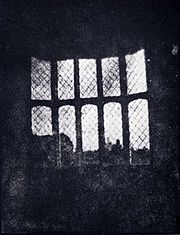 A latticed window in Lacock Abbey, England, photographed by William Fox Talbot in 1835. Shown here in positive form, this is the oldest known extant photographic negative made in a camera.
A latticed window in Lacock Abbey, England, photographed by William Fox Talbot in 1835. Shown here in positive form, this is the oldest known extant photographic negative made in a camera.
Meanwhile, Hercules Florence had already created a very similar process in 1832, naming it Photographie, and English inventor William Fox Talbot had earlier discovered another means to fix a silver process image but had kept it secret. After reading about Daguerre's invention, Talbot refined his process so that portraits were made readily available to the masses. By 1840, Talbot had invented the calotype process, which creates negative images.[17] Talbot's famous 1835 print of the Oriel window in Lacock Abbey is the oldest known negative in existence.[18][19] John Herschel made many contributions to the new methods. He invented the cyanotype process, now familiar as the "blueprint". He was the first to use the terms "photography", "negative" and "positive". He discovered sodium thiosulphate solution to be a solvent of silver halides in 1819, and informed Talbot and Daguerre of his discovery in 1839 that it could be used to "fix" pictures and make them permanent. He made the first glass negative in late 1839.
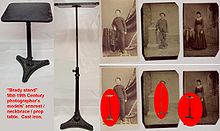 Mid 19th century "Brady stand" photo model's armrest table, meant to keep portrait models more still during long exposure times (studio equipment nicknamed after the famed US photographer, Mathew Brady).
Mid 19th century "Brady stand" photo model's armrest table, meant to keep portrait models more still during long exposure times (studio equipment nicknamed after the famed US photographer, Mathew Brady).
In March 1851, Frederick Scott Archer published his findings in "The Chemist" on the wet plate collodion process. This became the most widely used process between 1852 and the late 1860s when the dry plate was introduced. There are three subsets to the Collodion process; the Ambrotype (positive image on glass), the Ferrotype or Tintype (positive image on metal) and the negative which was printed on Albumen or Salt paper.
Many advances in photographic glass plates and printing were made in through the 19th century. In 1884, George Eastman developed the technology of film to replace photographic plates, leading to the technology used by film cameras today.
In 1908 Gabriel Lippmann won the Nobel Laureate in Physics for his method of reproducing colors photographically based on the phenomenon of interference, also known as the Lippmann plate.
Processes
Black-and-white
All photography was originally monochrome, or black-and-white. Even after color film was readily available, black-and-white photography continued to dominate for decades, due to its lower cost and its "classic" photographic look. It is important to note that some monochromatic pictures are not always pure blacks and whites, but also contain other hues depending on the process. The cyanotype process produces an image of blue and white for example. The albumen process, first used more than 150 years ago, produces brown tones.
Many photographers continue to produce some monochrome images, often because of the established archival permanence of well processed silver halide based materials.
Some full color digital images are processed using a variety of techniques to create black and whites, and some manufacturers produce digital cameras that exclusively shoot monochrome.
Color
Color photography was explored beginning in the mid-19th century. Early experiments in color required extremely long exposures (hours or days for camera images) and could not "fix" the photograph to prevent the color from quickly fading when exposed to white light.
The first permanent color photograph was taken in 1861 using the three-color-separation principle first published by physicist James Clerk Maxwell in 1855. Maxwell's idea was to take three separate black-and-white photographs through red, green and blue filters. This provides the photographer with the three basic channels required to recreate a color image. Transparent prints of the images could be projected through similar color filters and superimposed on the projection screen, an additive method of color reproduction. A color print on paper could be produced by superimposing carbon prints of the three images made in their complementary colors, a subtractive method of color reproduction pioneered by Louis Ducos du Hauron in the late 1860s. Russian photographer Sergei Mikhailovich Prokudin-Gorskii made extensive use of this color separation technique, employing a special camera which successively exposed the three color-filtered images on different parts of an oblong plate. Because his exposures were not simultaneous, unsteady subjects exhibited color "fringes" or, if rapidly moving through the scene, appeared as brightly colored ghosts in the resulting projected or printed images.
The development of color photography was held back by the limited sensitivity of early photographic materials, which were mostly sensitive to blue, only slightly sensitive to green and virtually insensitive to red. The discovery of dye sensitization by photochemist Hermann Vogel in 1873 suddenly made it possible to add sensitivity to green, yellow and even red. Improved color sensitizers and ongoing improvements in the overall sensitivity of emulsions steadily reduced the once-prohibitive long exposure times required for color, bringing it ever closer to commercial viability.
Autochrome, the first commercially successful color process, was introduced by the Lumière brothers in 1907. Autochrome plates incorporated a mosaic color filter layer made of dyed grains of potato starch, which allowed the three color components to be recorded as adjacent microscopic image fragments. After an Autochrome plate was reversal processed to produce a positive transparency, the starch grains served to illuminate each fragment with the correct color and the tiny colored points blended together in the eye, synthesizing the color of the subject by the additive method. Autochrome plates were one of several varieties of additive color screen plates and films marketed between the 1890s and the 1950s.
Kodachrome, the first modern "integral tripack" (or "monopack") color film, was introduced by Kodak in 1935. It captured the three color components in a multilayer emulsion. One layer was sensitized to record the red-dominated part of the spectrum, another layer recorded only the green part and a third recorded only the blue. Without special film processing, the result would simply be three superimposed black-and-white images, but complementary cyan, magenta, and yellow dye images were created in those layers by adding color couplers during a complex processing procedure. Agfa's similarly structured Agfacolor Neu was introduced in 1936. Unlike Kodachrome, the color couplers in Agfacolor Neu were incorporated into the emulsion layers during manufacture, which greatly simplified the processing. Currently available color films still employ a multilayer emulsion and the same principles, most closely resembling Agfa's product.
Instant color film, used in a special camera which yielded a unique finished color print only a minute or two after the exposure, was introduced by Polaroid in 1963.
Color photography may form images as positive transparencies, which can be used in a slide projector, or as color negatives intended for use in creating positive color enlargements on specially coated paper. The latter is now the most common form of film (non-digital) color photography owing to the introduction of automated photoprinting equipment.
Full-spectrum, ultraviolet and infrared
Ultraviolet and infrared films have been available for many decades and employed in a variety of photographic avenues since the 1960s. New technological trends in digital photography have opened a new direction in full spectrum photography, where careful filtering choices across the ultraviolet, visible and infrared lead to new artistic visions.
Modified digital cameras can detect some ultraviolet, all of the visible and much of the near infrared spectrum, as most digital imaging sensors are sensitive from about 350 nm to 1000 nm. An off-the-shelf digital camera contains an infrared hot mirror filter that blocks most of the infrared and a bit of the ultraviolet that would otherwise be detected by the sensor, narrowing the accepted range from about 400 nm to 700 nm.[20] Replacing a hot mirror or infrared blocking filter with an infrared pass or a wide spectrally transmitting filter allows the camera to detect the wider spectrum light at greater sensitivity. Without the hot-mirror, the red, green and blue (or cyan, yellow and magenta) colored micro-filters placed over the sensor elements pass varying amounts of ultraviolet (blue window) and infrared (primarily red, and somewhat lesser the green and blue micro-filters).
Uses of full spectrum photography are for fine art photography, geology, forensics & law enforcement, and even some claimed use in ghost hunting.
Digital photography
 The Nikon D1, the first DSLR to truly compete with, and begin to replace, film cameras in the professional photojournalism and sports photography fields.
The Nikon D1, the first DSLR to truly compete with, and begin to replace, film cameras in the professional photojournalism and sports photography fields.
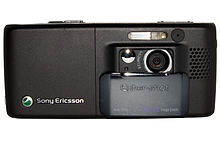 Sony Ericsson K800i. Such Camera phones, combined with photo sharing sites, have led to a new kind of social photography.
Sony Ericsson K800i. Such Camera phones, combined with photo sharing sites, have led to a new kind of social photography.
Traditional photography burdened photographers working at remote locations without easy access to processing facilities, and competition from television pressured photographers to deliver images to newspapers with greater speed. Photo journalists at remote locations often carried miniature photo labs and a means of transmitting images through telephone lines. In 1981, Sony unveiled the first consumer camera to use a charge-coupled device for imaging, eliminating the need for film: the Sony Mavica. While the Mavica saved images to disk, the images were displayed on television, and the camera was not fully digital. In 1991, Kodak unveiled the DCS 100, the first commercially available digital single lens reflex camera. Although its high cost precluded uses other than photojournalism and professional photography, commercial digital photography was born.
Digital imaging uses an electronic image sensor to record the image as a set of electronic data rather than as chemical changes on film. The primary difference between digital and chemical photography is that chemical photography resists photo manipulation because it involves film and photographic paper, while digital imaging is a highly manipulative medium. This difference allows for a degree of image post-processing that is comparatively difficult in film-based photography and permits different communicative potentials and applications.
Digital imaging has raised ethical concerns because of the ease of manipulating digital photographs in post-processing. Many photojournalists have declared they will not crop their pictures, or are forbidden from combining elements of multiple photos to make "photomontages," passing them as "real" photographs. Today's technology has made photo editing relatively simple for even the novice photographer. However, recent changes of in-camera processing allows digital fingerprinting of photos to detect tampering for purposes of forensic photography.
Digital point-and-shoot cameras have become widespread consumer products, outselling film cameras, and including new features such as video and audio recording. Kodak announced in January 2004 that it would no longer sell reloadable 35 mm cameras in western Europe, Canada and the United States after the end of that year. Kodak was at that time a minor player in the reloadable film cameras market. In January 2006, Nikon followed suit and announced that they will stop the production of all but two models of their film cameras: the low-end Nikon FM10, and the high-end Nikon F6. On May 25, 2006, Canon announced they will stop developing new film SLR cameras.[21] Though most new camera designs are now digital, a new 6x6cm/6x7cm medium format film camera was introduced in 2008 in a cooperation between Fuji and Voigtländer.[22][23]
According to a survey made by Kodak in 2007 when the majority of photography was already digital, 75 percent of professional photographers say they will continue to use film, even though some embrace digital.[24]
According to the U.S. survey results, more than two-thirds (68 percent) of professional photographers prefer the results of film to those of digital for certain applications including:
- film’s superiority in capturing more information on medium and large format films (48 percent);
- creating a traditional photographic look (48 percent);
- capturing shadow and highlighting details (45 percent);
- the wide exposure latitude of film (42 percent); and
- archival storage (38 percent)
Modes of production
Amateur
An amateur photographer is one who practices photography as a hobby and not for profit. The quality of some amateur work is comparable to that of many professionals and may be highly specialized or eclectic in its choice of subjects. Amateur photography is often pre-eminent in photographic subjects which have little prospect of commercial use or reward.
Commercial
Commercial photography is probably best defined as any photography for which the photographer is paid for images rather than works of art. In this light money could be paid for the subject of the photograph or the photograph itself. Wholesale, retail, and professional uses of photography would fall under this definition. The commercial photographic world could include:
- Advertising photography: photographs made to illustrate and usually sell a service or product. These images, such as packshots, are generally done with an advertising agency, design firm or with an in-house corporate design team.
- Fashion and glamour photography usually incorporates models. Photographers here are paid more because of the demand for good photographers to shoot the item being sold and incorporate the models beauty in the image. Fashion photography like the work featured in Harper's Bazaar emphasizes clothes and other products; glamour emphasizes the model and body form. Glamour photography is popular in advertising and men's magazines which means these pictures are more revealing than editorial fashion photography. Models in glamour photography sometimes work nude.
- Crime scene photography consists of photographing scenes of crime such as robberies and murders. A black and white camera or an infrared camera may be used to capture specific details.
- Still life photography usually depicts inanimate subject matter, typically commonplace objects which may be either natural or man-made.
- Food photography can be used for editorial, packaging or advertising use. Food photography is similar to still life photography, but requires some special skills.
- Editorial photography illustrates a story or idea within the context of a magazine. These are usually assigned by the magazine.
- Photojournalism can be considered a subset of editorial photography. Photographs made in this context are accepted as a documentation of a news story.
- Portrait and wedding photography: photographs made and sold directly to the end user of the images.
- Landscape photography depicts locations.
- Wildlife photography demonstrates the life of animals.
The market for photographic services demonstrates the aphorism "A picture is worth a thousand words", which has an interesting basis in the history of photography. Magazines and newspapers, companies putting up Web sites, advertising agencies and other groups pay for photography.
Many people take photographs for self-fulfillment or for commercial purposes. Organizations with a budget and a need for photography have several options: they can employ a photographer directly, organize a public competition, or obtain rights to stock photographs. Photo stock can be procured through traditional stock giants, such as Getty Images or Corbis; smaller microstock agencies, such as Fotolia; or web marketplaces, such as Cutcaster.
Art
During the 20th century, both fine art photography and documentary photography became accepted by the English-speaking art world and the gallery system. In the United States, a handful of photographers, including Alfred Stieglitz, Edward Steichen, John Szarkowski, F. Holland Day, and Edward Weston, spent their lives advocating for photography as a fine art. At first, fine art photographers tried to imitate painting styles. This movement is called Pictorialism, often using soft focus for a dreamy, 'romantic' look. In reaction to that, Weston, Ansel Adams, and others formed the Group f/64 to advocate 'straight photography', the photograph as a (sharply focused) thing in itself and not an imitation of something else.
The aesthetics of photography is a matter that continues to be discussed regularly, especially in artistic circles. Many artists argued that photography was the mechanical reproduction of an image. If photography is authentically art, then photography in the context of art would need redefinition, such as determining what component of a photograph makes it beautiful to the viewer. The controversy began with the earliest images "written with light"; Nicéphore Niépce, Louis Daguerre, and others among the very earliest photographers were met with acclaim, but some questioned if their work met the definitions and purposes of art.
Clive Bell in his classic essay Art states that only "significant form" can distinguish art from what is not art.
There must be some one quality without which a work of art cannot exist; possessing which, in the least degree, no work is altogether worthless. What is this quality? What quality is shared by all objects that provoke our aesthetic emotions? What quality is common to Sta. Sophia and the windows at Chartres, Mexican sculpture, a Persian bowl, Chinese carpets, Giotto's frescoes at Padua, and the masterpieces of Poussin, Piero della Francesca, and Cezanne? Only one answer seems possible — significant form. In each, lines and colors combined in a particular way, certain forms and relations of forms, stir our aesthetic emotions.—[25]On February 14, 2006 Sotheby’s London sold the 2001 photograph "99 Cent II Diptychon" for an unprecedented $3,346,456 to an anonymous bidder making it the most expensive of all time.
- Photography that turns a concept or idea into a photograph. Even though what is depicted in the photographs are real objects, the subject is strictly abstract.
Science and forensics
The camera has a long and distinguished history as a means of recording phenomena from the first use by Daguerre and Fox-Talbot, such as astronomical events (eclipses for example), small creatures and plants when the camera was attached to the eyepiece of microscopes (in photomicroscopy) and for macro photography of larger specimens. The camera also proved useful in recording crime scenes and the scenes of accidents, such as the Wootton bridge collapse in 1861. The methods used in analysing photographs for use in legal cases are collectively known as forensic photography.
By 1853, Charles Brooke had invented a technology for the automatic registration of instruments by photography. These instruments included barometers, thermometers, psychrometers, and magnetometers, which recorded their readings by means of an automated photographic process.[26]
Photography has become ubiquitous in recording events and data in science and engineering, and at crime scenes or accident scenes. The method has been much extended by using other wavelengths, such as infrared photography and ultraviolet photography, as well as spectroscopy. Those methods were first used in the Victorian era and developed much further since that time.[27]
Other image forming techniques
Besides the camera, other methods of forming images with light are available. For instance, a photocopy or xerography machine forms permanent images but uses the transfer of static electrical charges rather than photographic film, hence the term electrophotography. Photograms are images produced by the shadows of objects cast on the photographic paper, without the use of a camera. Objects can also be placed directly on the glass of an image scanner to produce digital pictures.
Social and cultural implications
There are many ongoing questions about different aspects of photography. In her writing "On Photography" (1977), Susan Sontag discusses concerns about the objectivity of photography. This is a highly debated subject within the photographic community.[28] Sontag argues, "To photograph is to appropriate the thing photographed. It means putting one’s self into a certain relation to the world that feels like knowledge, and therefore like power."[29] Photographers decide what to take a photo of, what elements to exclude and what angle to frame the photo, and these factors may reflect a particular socio-historical context. Along these lines it can be argued that photography is a subjective form of representation.
Modern photography has raised a number of concerns on its impact on society. In Alfred Hitchcock's Rear Window (1954), the camera is presented as promoting voyeurism. 'Although the camera is an observation station, the act of photographing is more than passive observing'.[29] Michal Powell's Peeping Tom (1960) portrays the camera as both sexual and sadistically violent technology that literally kills in this picture and at the same time captures images of the pain and anguish evident on the faces of the female victims.[citation needed]
"The camera doesn't rape or even possess, though it may presume, intrude, trespass, distort, exploit, and, at the farthest reach of metaphor, assassinate - all activities that, unlike the sexual push and shove, can be conducted from a distance, and with some detachment."[29]
Photography is one of the new media forms that changes perception and changes the structure of society.[30] Further unease has been caused around cameras in regards to desensitization. Fears that disturbing or explicit images are widely accessible to children and society at large have been raised. Particularly, photos of war and pornography are causing a stir. Sontag is concerned that "to photograph is to turn people into objects that can be symbolically possessed." Desensitization discussion goes hand in hand with debates about censored images. Sontag writes of her concern that the ability to censor pictures means the photographer has the ability to construct reality.[29]
One of the practices through which photography constitutes society is tourism. Tourism and photography combine to create a "tourist gaze"[31] in which local inhabitants are positioned and defined by the camera lens. However, it has also been argued that there exists a "reverse gaze"[32] through which indigenous photographees can position the tourist photographer as a shallow consumer of images.
Additionally, photography has been the topic of many songs in popular culture.
Law
Photography is both restricted and protected by the law in many jurisdictions. Protection of photographs is typically achieved through the granting of copyright or moral rights to the photographer. In the UK a recent law (Counter-Terrorism Act 2008) increases the power of the police to prevent people, even press photographers, from taking pictures in public places.[33]
See also
References
- ^ Spencer, D A (1973). The Focal Dictionary of Photographic Technologies. Focal Press. p. 454. ISBN 240 50747 9.
- ^ Eder, J.M (1945) [1932]. History of Photography, 4th. edition [Geschichte der Photographie]. New York: Dover Publications, Inc.. pp. 258–259. ISBN 0486235866.
- ^ Online Etymology Dictionary
- ^ Dpreview.com
- ^ Joseph and Barbara Anderson, "The Myth of Persistence of Vision Revisited," Journal of Film and Video, Vol. 45, No. 1 (Spring 1993): 3–12. uca.edu
- ^ a b c "The First Photograph — Heliography". http://www.hrc.utexas.edu/exhibitions/permanent/wfp/heliography.html. Retrieved 2009-09-29. "from Helmut Gernsheim's article, "The 150th Anniversary of Photography," in History of Photography, Vol. I, No. 1, January 1977: ...In 1822, Niépce coated a glass plate... The sunlight passing through... This first permanent example... was destroyed... some years later."
- ^ Jan Campbell (2005). "Film and cinema spectatorship: melodrama and mimesis". Polity. p. 114. ISBN 0-7456-2930-X
- ^ a b Robert E. Krebs (2004). Groundbreaking Scientific Experiments, Inventions, and Discoveries of the Middle Ages and the Renaissance. Greenwood Publishing Group. ISBN 0-3133-2433-6. http://books.google.com/?id=MTXdplfiz-cC&pg=PA20&dq=Mo-Ti+pinhole+camera+obscura.
- ^ Alistair Cameron Crombie, Science, optics, and music in medieval and early modern thought, p. 205
- ^ Wade, Nicholas J.; Finger, Stanley (2001). "The eye as an optical instrument: from camera obscura to Helmholtz's perspective". Perception 30 (10): 1157–77. doi:10.1068/p3210. PMID 11721819.
- ^ Davidson, Michael W; National High Magnetic Field Laboratory at The Florida State University (2003-08-01). "Molecular Expressions: Science, Optics and You - Timeline - Albertus Magnus". The Florida State University. http://micro.magnet.fsu.edu/optics/timeline/people/magnus.html. Retrieved 2009-11-28.
- ^ Georges Potonniée (1973). "The history of the discovery of photography". Arno Press. p. 50. ISBN 0-4050-4929-3
- ^ a b Helmut Gernsheim (1986). "A concise history of photography". Courier Dover Publications. pp. 3–4. ISBN 0-4862-5128-4
- ^ Helmut Gernsheim, Alison Gernsheim (1955). "The history of photography from the earliest use of the camera obscura in the eleventh century up to 1914". Oxford University Press. p. 20.
- ^ Witt, Brown, Dunbar, Tirro, Witt. The Humanities, Cultural Roots and Continuities, Seventh Edition. Houghton Mifflin Company. Boston. New York. 2005
- ^ Seizing the Light: A History of Photography By Robert Hirsch
- ^ BBC - History - Historic Figures: William Henry Fox Talbot (1800 - 1877) BBC
- ^ Anthony Feldman, Peter Ford (1989) Scientists & inventors p.128. Bloomsbury Books, 1989
- ^ William H. Fox Talbot, inventor of the negative-positive process p.95. Macmillan, 1973
- ^ Spectral curves of RGB and Hot Mirror filters.
- ^ “Canon to Stop Making Single-Lens Camera” Associated Press, 25 May 2006. Retrieved 2 September 2006.
- ^ Voigtlaender.de
- ^ The new Voigtlaender Vitolux S70 and Bessa III 667
- ^ www.photographypress.co.uk
- ^ Clive Bell. "Art", 1914. Retrieved 2 September 2006.
- ^ "Photographic self-registering magnetic and meteorological apparatus: Invented by Mr. Brooke of Keppel-Street, London". The Illustrated Magazine of Art (New York: Alexander Montgomery) 1: 308–311. 1853. http://books.google.com/books?id=DhfnAAAAMAAJ&pg=PA309.
- ^ Herbert L. Blitzer, Karen Stein-Ferguson, Jeffrey Huang (2008). Understanding forensic digital imaging. Academic Press. pp. 8–9. ISBN 9780123704511. http://books.google.com/books?id=a0nmdTmHMrIC&pg=PA8.
- ^ Bissell, K.L., Photography and Objectivity (2000) findarticles.com . Retrieved 24 October 2008.
- ^ a b c d Sontag, S., On Photography, Penguin, London (1977), pp 3–24.
- ^ Levinson, P., The Soft Edge: a Natural History and Future of the Information Revolution, Routledge, London and New York (1997), pp 37–48.
- ^ John Urry (2002). The tourist gaze (2nd ed.). SAGE. ISBN 9780761973478. http://books.google.com/?id=bhhtg1sz0YAC&printsec=frontcover#v=onepage&q=.
- ^ Alex Gillespie. "Tourist Photography and the Reverse Gaze". http://stir.academia.edu/documents/0011/0117/Gillespie_tourist_photography_and_the_reverse_gaze.pdf.
- ^ British Journal of Photography article
Further reading
Introduction
- Photography. A Critical Introduction [Paperback], ed. by Liz Wells, 3rd edition, London [etc.]: Routledge, 2004, ISBN 041530704X
History
- A New History of Photography, ed. by Michel Frizot, Köln : Könemann, 1998
- Franz-Xaver Schlegel, Das Leben der toten Dinge - Studien zur modernen Sachfotografie in den USA 1914-1935, 2 Bände, Stuttgart/Germany: Art in Life 1999, ISBN 3-00-004407-8.
Reference works
- Tom Ang (2002). Dictionary of Photography and Digital Imaging: The Essential Reference for the Modern Photographer. Watson-Guptill. ISBN 0817437894. http://books.google.com/?id=fu3akyrFZEMC&pg=PP1&dq=intitle:Dictionary+intitle:of+intitle:Photography+intitle:and+intitle:Digital+intitle:Imaging+inauthor:ang.
- Hans-Michael Koetzle: Das Lexikon der Fotografen: 1900 bis heute, Munich: Knaur 2002, 512 p., ISBN 3-426-66479-8
- John Hannavy (ed.): Encyclopedia of Nineteenth-Century Photography, 1736 p., New York: Routledge 2005 ISBN 978-0415972352
- Lynne Warren (Hrsg.): Encyclopedia of Twentieth-Century Photography, 1719 p., New York, NY [et.] : Routledge, 2006
- The Oxford Companion to the Photograph, ed. by Robin Lenman, Oxford University Press 2005
Other books
- Photography and The Art of Seeing by Freeman Patterson, Key Porter Books 1989, ISBN 1-55013-099-4.
- The Art of Photography: An Approach to Personal Expression by Bruce Barnbaum, Rocky Nook 2010, ISBN 1933952687.
- Image Clarity: High Resolution Photography by John B. Williams, Focal Press 1990, ISBN 0-240-80033-8.
External links
- World History of Photography From The History of Art.
- Daguerreotype to Digital: A Brief History of the Photographic Process From the State Library & Archives of Florida.
- Shades of Light (Australian Photography 1839 - 1988) the online version of the original Shades of Light published 1998, Gael Newton, National Gallery of Australia.
Visual arts Computer art · Decorative arts · Drawing · Filmmaking · New media · Painting · Photography · Printmaking · SculptureCategories:- Photography
- 1822 introductions
- Greek loanwords
- Optics
Wikimedia Foundation. 2010.

